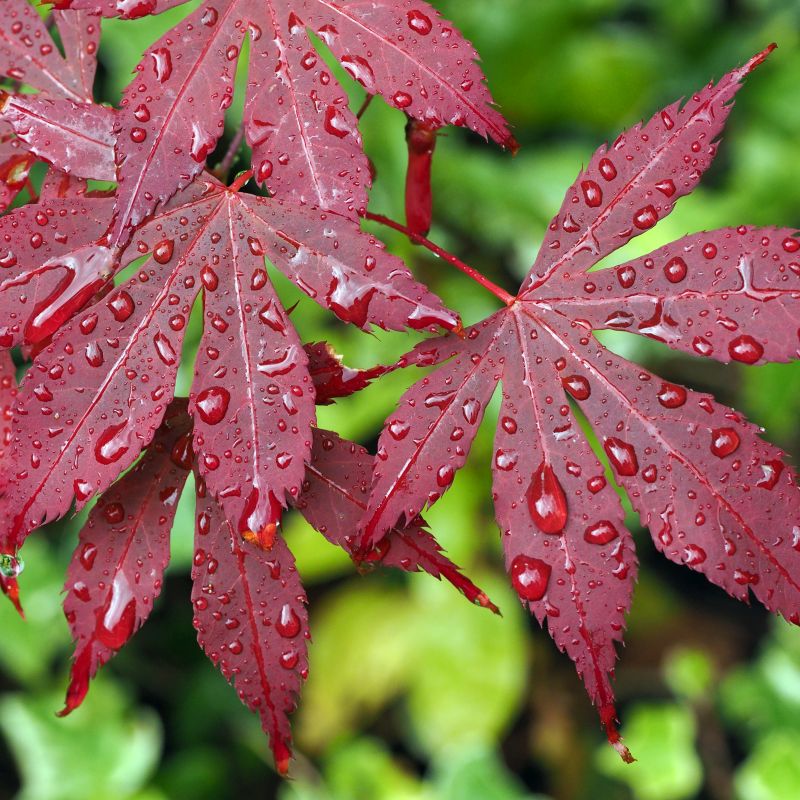When it comes to Japanese maples, one is often overwhelmed by the shear amount of diversity within this species. One of the most beloved ornamental trees in modern cultivation! It’s easy to see why, given the scope of diversity amongst the different varieties. With some growing into trees around 20’-25’ to varieties being smaller, diminutive “shrubs”, a staggering variance in leaf color, size, shape with some varieties sporting amazing bark colors and textures. With several hundred cultivars in production there’s bound to be one that suits your needs!
Site Selection
The best location for Japanese maples is an area that gets morning sun, with protection from the hot afternoon sun. Another good place is under the canopies of larger shade trees, that will provide dappled shade for these beautiful trees. Some varieties can take more sun than others, but for the best growth and leaf color and quality, please refrain from planting in the afternoon sun. They will look healthy going into June, but the Kansas City summer heat will soon degrade their appearance, making recovery difficult and limiting growth. There is a big difference between a plant surviving, and a plant thriving, and while they may survive, they will rarely thrive in full sun.
Pruning
There are many schools of thought regarding when the best time is to prune your maple. As always, it’s best to sanitize your pruning implements with a 10% alcohol or bleach solution. Pruning should be done late summer to mid-fall when the sap isn’t flowing as much. Avoid pruning late winter through mid-spring as the sap is flowing the quickest and can create entry points for diseases and insects. After your initial shaping of your Japanese maple, it will require minimal pruning. Dead or damaged branches can be removed regardless of the time of year.
Fertilizing
I’ve had wonderful success using a low nitrogen, acidifying fertilizer to be the most effective when it comes to feeding Japanese maples. My go-to fertilizer for them is Espoma Holly-Tone, as it’s a slow release, organic option and has supplemental beneficial microbes that aid in soil biodiversity. Feed your tree according to the package instructions for your trees current size.
Broad-leaved Japanese Maples- (Acer palmatum)
Japanese maples in this family have broad, deeply lobed leaves, coming in a varied selection of colors, mature size, and even variegated forms! Displaying probably the greatest variants of ultimate sizes, they can grow anywhere between 3’-4’ tall and wide all the way to 20’ and above! While this group can take more sun, they perform the best with afternoon shade. Some of the most common varieties are Bloodgood, Emperor 1, and Twombly’s Red Sentinel.
Lace Leaf Japanese Maple- (Acer palmatum dissectum)
Lace leaved Japanese maples are some of the most graceful and elegant of the species. Often growing to 6’-8’ tall and wide, they can be kept smaller with judicious pruning. This type must be kept out of the afternoon sun, as its beautiful lacey foliage will scorch in KC summers. While there are many cultivars, the most vigorous are Crimson Queen, Red Dragon and Tamukeyama.
Full Moon Maple- (Acer japonicum)
Full moon maples are rarer in cultivation than others in the family but are no less desirable! Having the largest leaves, has great insect and disease resistance, and amazing fall color, boasting alluring hues of bright orange, reds and yellow. Often a large multi-stemmed shrub or small tree. While they can be a little ungainly as a young plant, mature specimens have a character all their own, and are always beautiful! Look for Aconitifolium, Green Cascade and Vitifolium are some of the most commonly available specimens.
Golden Full Moon Maple- (Acer shirasawanum)
Golden Full Moons are very closely related to Full Moon maples, but with golden leaves. These broad-leaved maples must be in shade in the afternoon, or the luscious golden leaves will burn. They are somewhat slow growing, and larger specimens command a large price and a place of prominence in your landscape! The best cultivars are Autumn Moon, Moonrise, and Jordan, and all of them sport beautiful fall color!
Let’s Re-cap!
Hopefully this quick look in Japanese maples has been informative! Now that you’ve learned the best areas to plant one, when to prune and fertilize, it might be time for you to consider one for your landscape! If you ever have questions regarding maples or any other type of tree, feel free to come see me at Colonial Gardens or send me an email at travis.m@colonialgardenskc.com.
Thanks for your thyme!
Written By "Trav the Tree Guy" Travis Morcha

.webp)




